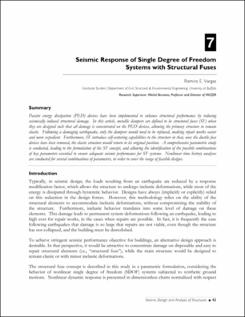| dc.contributor.author | Vargas, Ramiro | |
| dc.date.accessioned | 2017-08-16T14:42:54Z | |
| dc.date.accessioned | 2017-08-16T14:42:54Z | |
| dc.date.available | 2017-08-16T14:42:54Z | |
| dc.date.available | 2017-08-16T14:42:54Z | |
| dc.date.issued | 2004-06-25 | |
| dc.date.issued | 2004-06-25 | |
| dc.identifier.uri | http://ridda2.utp.ac.pa/handle/123456789/2540 | |
| dc.identifier.uri | http://ridda2.utp.ac.pa/handle/123456789/2540 | |
| dc.description | Passive energy dissipation (PED) devices have been implemented to enhance structural performance by reducing seismically induced structural damage. In this article, metallic dampers are defined to be structural fuses (SF) when they are designed such that all damage is concentrated on the PED devices, allowing the primary structure to remain elastic. Following a damaging earthquake, only the dampers would need to be replaced, making repair works easier and more expedient. Furthermore, SF introduce self-centering capabilities to the structure in that, once the ductile fuse devices have been removed, the elastic structure would return to its original position. A comprehensive parametric study is conducted, leading to the formulation of the SF concept, and allowing the identification of the possible combinations of key parameters essential to ensure adequate seismic performance for SF systems. Nonlinear time history analyses are conducted for several combinations of parameters, in order to cover the range of feasible designs. | en_US |
| dc.description.abstract | Passive energy dissipation (PED) devices have been implemented to enhance structural performance by reducing seismically induced structural damage. In this article, metallic dampers are defined to be structural fuses (SF) when they are designed such that all damage is concentrated on the PED devices, allowing the primary structure to remain elastic. Following a damaging earthquake, only the dampers would need to be replaced, making repair works easier and more expedient. Furthermore, SF introduce self-centering capabilities to the structure in that, once the ductile fuse devices have been removed, the elastic structure would return to its original position. A comprehensive parametric study is conducted, leading to the formulation of the SF concept, and allowing the identification of the possible combinations of key parameters essential to ensure adequate seismic performance for SF systems. Nonlinear time history analyses are conducted for several combinations of parameters, in order to cover the range of feasible designs. | en_US |
| dc.language | eng | |
| dc.language.iso | eng | en_US |
| dc.rights | https://creativecommons.org/licenses/by-nc-sa/4.0/ | |
| dc.rights | info:eu-repo/semantics/openAccess | |
| dc.subject | Passive energy devices (PED) | en_US |
| dc.subject | Structural performance | en_US |
| dc.subject | Seismic damage | en_US |
| dc.subject | Metallic dampers | en_US |
| dc.subject | Structural fuses (SF) | en_US |
| dc.subject | Elasticity, Seismic performance | en_US |
| dc.subject | Retrofitting | en_US |
| dc.subject | Buckling-restrained braces (BRB) | en_US |
| dc.subject | Triangular added damping and stiffness (T-ADAS) | en_US |
| dc.subject | Shear panels (SP) | en_US |
| dc.subject | Single degree of freedom (SDOF) systems | en_US |
| dc.subject | Multidegree of freedom (MDOF) systems | en_US |
| dc.subject | Floor demands velocities | en_US |
| dc.subject | Accelerations | en_US |
| dc.subject | Nonstructural damage | en_US |
| dc.subject | Shaking table tests | en_US |
| dc.subject | Moment-resisting connections | en_US |
| dc.subject | Seismic isolation | en_US |
| dc.subject | Ball-in-cone (BNC) system | en_US |
| dc.subject | Pin connections | en_US |
| dc.subject | Passive energy devices (PED) | |
| dc.subject | Structural performance | |
| dc.subject | Seismic damage | |
| dc.subject | Metallic dampers | |
| dc.subject | Structural fuses (SF) | |
| dc.subject | Elasticity, Seismic performance | |
| dc.subject | Retrofitting | |
| dc.subject | Buckling-restrained braces (BRB) | |
| dc.subject | Triangular added damping and stiffness (T-ADAS) | |
| dc.subject | Shear panels (SP) | |
| dc.subject | Single degree of freedom (SDOF) systems | |
| dc.subject | Multidegree of freedom (MDOF) systems | |
| dc.subject | Floor demands velocities | |
| dc.subject | Accelerations | |
| dc.subject | Nonstructural damage | |
| dc.subject | Shaking table tests | |
| dc.subject | Moment-resisting connections | |
| dc.subject | Seismic isolation | |
| dc.subject | Ball-in-cone (BNC) system | |
| dc.subject | Pin connections | |
| dc.title | Seismic Response of Single-Degree-of-Freedom Systems with Structural Fuses | en_US |
| dc.type | info:eu-repo/semantics/article | |
| dc.type | info:eu-repo/semantics/publishedVersion | |
